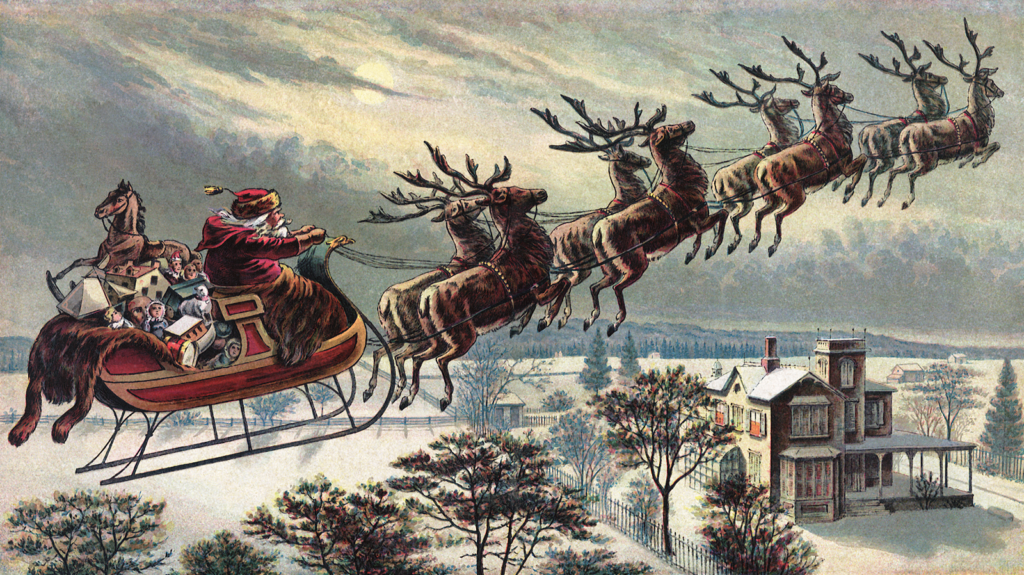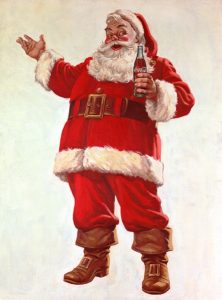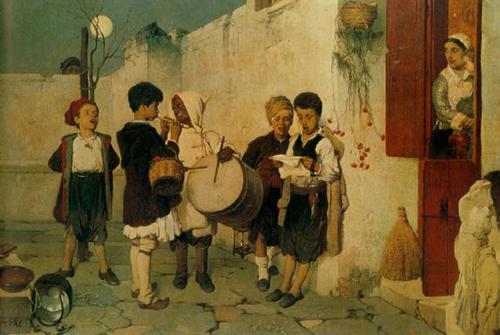
From its modest beginning, Christmas has evolved into the biggest celebration in the world. Here are some interesting facts and origins about a few of the Christmas traditions we know today:
Satire first sent Santa down a chimney: In his satiric 1809 book A History of New York, Washington Irving did away with the characterization of Santa Claus as a “lanky bishop”. Instead, Irving described Santa as a portly, bearded man who smokes a pipe. Irving’s story also marked the first time Santa slid down the chimney.
“Twas the Night Before Christmas” introduced the reindeer: Clement Moore’s 1822 poem A Visit From Saint Nicholas, which is now more commonly referred to as “Twas the Night Before Christmas”, was first published anonymously in the Troy, N.Y., Sentinel on Dec. 23, 1823. The 56-line poem introduced and popularized many of Santa’s defining characteristics, chiefly that he drove a sleigh guided by “eight tiny reindeer.”


Coca-Cola created the modern Mr. Claus: When Father Christmas first began showing up in illustrations, he wore many different coloured robes. Beginning in the late 1800s, it became popular to outfit Santa in a red suit. Artist Louis Prang depicted him that way in a series of Christmas cards in 1885, and The New York Times reported on the red garments in 1927. But the modern image of Santa Claus as the jolly man in the red suit was seared into American pop culture in 1931, when artist Haddon Sundblom illustrated him that way for a widely-circulated campaign for Coca-Cola.
The department store Santa: In 1890, Massachusetts businessman James Edgar is said to have been the first department store Santa. Edgar is credited with coming up with the idea of dressing up in a Santa Claus costume as a marketing tool. Children from all over the state dragged their parents to Edgar’s small dry goods store in Brockton, and a tradition was born.
Santa was a bachelor until the late 1800s: The first mention of a spouse for Santa was in the 1849 short story A Christmas Legend by James Rees. Over the next several years, the idea of Mrs. Claus found its way into several literary publications, like the Yale Literary Magazine and Harper’s Magazine. But it wasn’t until Katherine Lee Bates’ widely-circulated 1889 poem Goody Santa Claus on a Sleigh Ride that Santa’s wife was popularized. (“Goody” is short for “Goodwife,” or “Mrs.”).
Christmas Carols: In the Holiday Season, we begin to hear their familiar strains on the radio and in department stores. Carols are such a basic part of our lives and our Christmas history that we often take them for granted and we hardly ever think about the significance of the words or the origin of the lovely melodies.
In their earliest beginnings, carols really had nothing to do with Christmas – or even with Christianity for that matter. The melodies were originally written to accompany an ancient dance form called the circle dance which was associated with fertility rites and pagan festivities in the medieval Celtic countries of Europe. As the Christian Church established itself in these areas, the familiar melodies and rhythms of carols found their way into Christian meetings and celebrations. But because the songs had such pagan roots, the Church was very uneasy about them for a long time. In fact, a Church Council in the mid-Seventh Century explicitly forbade Christians to sing carols, and the Church continued to frown on carols well into the Twelfth Century. (See, kids, the old fogies have always been against hip music!)
History credits Saint Francis of Assisi with bringing about a new interest in the feast of the Nativity and the Babe in Bethlehem. The priests in St. Francis’ order developed a style of religious folk song called a lauda. The religious lauda got mixed together with a popular pagan custom called wassailing, in which people sang from door to door to drive away evil spirits and drank to the health of those they visited. What evolved from the marriage of wassailing and the lauda was the custom of caroling, which is still so much a part of our Christmases some seven centuries later.
By the Seventeenth Century it was clear that everyone was having entirely too much fun! So the Grinch – otherwise known as the Puritan English Parliament – decided to abolish Christmas altogether! That’s right….not only did the carols get the axe, but the entire Christmas Holiday was eliminated. People who continued to celebrate the birth of Christ with happy and lighthearted carol singing were actually accused of witchcraft and risked imprisonment or death! It took several dark and gloomy decades before the prohibition against carol singing was lifted and people again began to write and sing carols freely. Many carols have been written since & are still popularized to date as we all know by Sir Cliff Richard!
In Cyprus Beautiful carols called “kalanda” have been handed down from Byzantine times and on Christmas Eve, groups of children go from one house to the next asking if they can sing the Kalanda. The singing of the Kalanda is considered a blessing to each household, so those who are thus honoured usually offer gifts to the singers.









